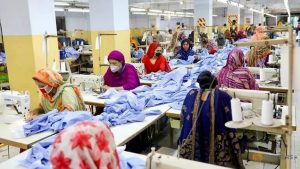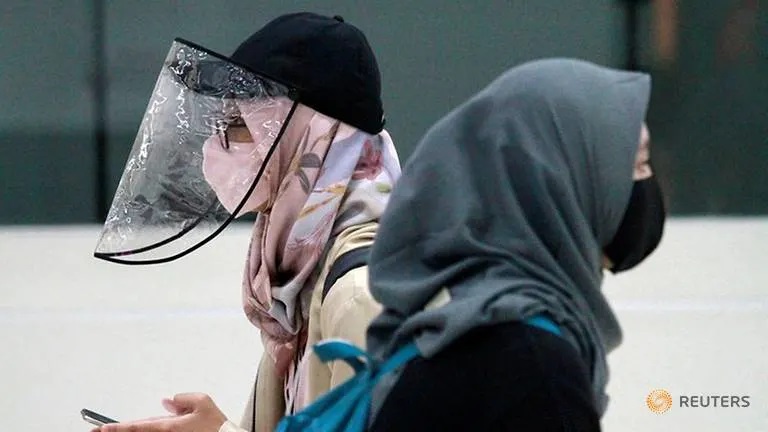Previous pandemics show that women are worse-off in terms of economic security and job opportunities, say observers.

FILE PHOTO: Women are pictured wearing protective face masks and face shields as the Indonesian government eases restrictions amid the spread of the coronavirus outbreak, in Jakarta, Indonesia.
SYDNEY: The global research evidence is clear: Economic crises exacerbate pre-existing inequalities, damaging the employment opportunities and economic security of women more than men.
The 1980s debt crisis, the 1997 Asian financial crisis and the 2008 Global Financial Crisis all provide stark warnings to governments and businesses that recent efforts to promote gender equality and economic empowerment will be undone unless women are prioritised in COVID-19 recovery planning and policymaking.
A review of the research on the gendered impact of economic crises highlights what is at stake.
ECONOMIC AND JOBS IMPACT
Women’s participation in formal employment, political representation, health outcomes and educational achievement declines during and after periods of economic crisis creating a long-term negative impact on women’s human capital formation and economic security.
The severity of the impact on women and gender equality depends on the scale and depth of the crisis. Multi-dimensional crises have the strongest impact on women’s socioeconomic equality and economic security.
The COVID-19 crisis has already caused an immediate global contraction in economic demand and supply.
The IMF predicts that the economic fallout will be “the worst recession since the Great Depression, and far worse than the Global Financial Crisis”.
The International Labour Organization estimates that the reduction in global working hours in the second quarter of 2020 will be equivalent to 305 million full-time jobs.
WOMEN MORE AFFECTED
Early evidence shows women are most affected by the immediate crisis.
Social distancing requirements and the closure of national borders have seen highly feminised sectors, including retail trade, accommodation, food services, tourism and export-oriented manufacturing hit hardest.
Hundreds of millions of women employed in these sectors were laid-off in the first month of the crisis and more will follow.

FILE PHOTO: Women work in a garment factory, as factories reopened after the government has eased the restrictions amid concerns over the coronavirus disease (COVID-19) outbreak in Dhaka, Bangladesh, May 3, 2020.
The impact on women across Asia has been particularly harsh with thousands of textile factories employing millions of women in Bangladesh, Myanmar, Cambodia, Vietnam, Indonesia and South Korea closing as supply chains were disrupted.
Layoffs are expected to deepen with reports of large clothing companies in export markets like Australia cancelling orders, delaying payments or asking for discounts on millions of dollars of goods.
The crisis has had an immediate and devastating impact on women employed in the informal economy across Asia.
The Asian Development Bank estimates small and medium-sized enterprises account for 96 per cent of all businesses in Asia.
Already highly vulnerable and typically without access to social protection benefits, the COVID-19 lockdowns have seen an immediate contraction in women’s business leaving millions of households exposed to poverty.
WORSE IN ASIA
A recent economic analysis suggests poverty could increase in Asia for the first time since 1990.
Alongside these aspects of the pandemic, lockdowns haves seen all aspects of life confined to the home.
This has produced a crisis in care, particularly where there has been widespread closure of schools and childcare centres, and where companies have required workers to work from home.
This has seen an intensification of gender inequality in the home with early evidence showing women are bearing the brunt of the care load.
Women’s labour force participation of those aged 25 to 54 in East and Southeast Asia has drifted down from 78 per cent to 76 per cent over the past two decades.
With women disproportionately represented in industries most affected by current job losses, this rate will likely decline further.
Evidence from previous crises shows sexist assumptions by employers that men have a stronger claim to jobs than women during times of crisis can entrench a male-breadwinner bias in employment and retrenchment decisions.
These assumptions are linked to gender norms that also shape household decisions about women’s labour supply and the division of labour overall.
But an alternative outcome is possible.
Prior to the COVID-19 crisis, a global consensus for gender equality and women’s economic empowerment was gaining significant momentum.
Women’s participation in the economy has been framed as a key to global growth by leading international agencies such as the World Bank and the IMF.

Women wearing face masks ride past the Opera House in Hanoi on Apr 23, 2020.
The business case for gender equality remains as robust as ever and, if handled appropriately, the pandemic presents a number of opportunities to “build back better” and improve women’s equality in the workplace.
The widespread use of new working arrangements, including working from home, flexible hours and some new forms of leave are providing men and employers the opportunity to experience the benefits of flexible work and carer’s leave.
The COVID-19 crisis provides an opportunity to re-think work and embed transformative leave policies and working arrangements.
The work-from-home experience has also exposed many men to the amount of care and domestic work required to run a household. Some experts suggest that this experience could prompt a shift in social norms and men’s attitudes to care.
The historical evidence tells us that the risks to gender equality posed by the COVID-19 crisis are real.
Gender equality post-COVID-19 will require government and business to include women as leaders and participants in recovery planning.
Governments must also fund social care and employers must support workplace practices that do not discriminate against workers with care responsibilities.
The IMF expects global growth will rebound once the crisis is contained, but will women share equally the benefits of the recovery?



